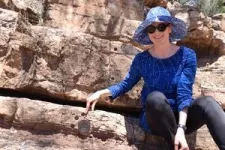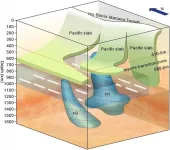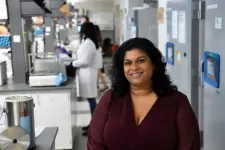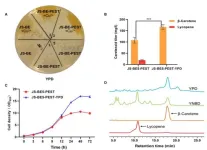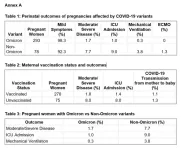(Press-News.org) Scientists from the Universities of Sydney and Sorbonne University have used the geological record of the deep sea to discover a connection between the orbits of Earth and Mars, past global warming patterns and the speeding up of deep ocean circulation.
They discovered a surprising 2.4-million-year cycle where deep currents wax and wane which, in turn, is linked to periods of increased solar energy and a warmer climate.
The study, published in Nature Communications, tackles the questions of how geological-timescale climate change affects ocean circulation and how this could help scientists to model future climates outcomes. The researchers looked to find if ocean-bottom currents become more vigorous or more sluggish in a warmer climate.
These cycles are not linked to the current rapid global warming caused by human greenhouse gas emissions.
Lead author ARC Future Fellow Dr Adriana Dutkiewicz from the University of Sydney EarthByte Group in the School of Geosciences and co-authors used more than half a century of scientific drilling data from hundreds of sites worldwide to understand the vigour of deep-sea currents through time.
In a collaboration with Professor Dietmar Müller (University of Sydney) and Associate Professor Slah Boulila (Sorbonne), Dr Dutkiewicz used the deep-sea sediment record to check for links between sedimentary shifts and changes in the Earth’s orbit.
They found that the vigour of deep-sea currents shifts in 2.4-million-year cycles.
These cycles are called “astronomical grand cycles”, predicted to occur due to the interactions of Earth and Mars orbits. However, evidence for this is rarely detected in the geological record.
Dr Dutkiewicz said: “We were surprised to find these 2.4-million-year cycles in our deep-sea sedimentary data. There is only one way to explain them: they are linked to cycles in the interactions of Mars and Earth orbiting the Sun.”
Co-author Professor Müller said: “The gravity fields of the planets in the solar system interfere with each other and this interaction, called a resonance, changes planetary eccentricity, a measure of how close to circular their orbits are.”
For the Earth it means periods of higher incoming solar radiation and warmer climate in cycles of 2.4 million years. The researchers found that the warmer cycles correlate with an increased occurrence of breaks in the deep-sea record, related to more vigorous deep ocean circulation.
The study has identified that deep eddies were an important component of earlier warming seas. It is possible these could partly mitigate ocean stagnation some have predicted could follow a faltering AMOC (Atlantic meridional overturning circulation) that drives the Gulf Stream and maintains temperate climates in Europe.
Professor Müller said: "We know there are at least two separate mechanisms that contribute to the vigour of deep-water mixing in the oceans. AMOC is one of them, but deep ocean eddies seem to play an important role in warm climates for keeping the ocean ventilated.
"Of course, this would not have the same effect as AMOC in terms of transporting water masses from low to high latitudes and vice-versa."
These eddies are like giant whirlpools and often reach the abyssal seafloor, resulting in seafloor erosion and large sediment accumulations called contourites, akin to snowdrifts.
Dr Dutkiewicz said: “Our deep-sea data spanning 65 million years suggest that warmer oceans have more vigorous deep circulation. This will potentially keep the ocean from becoming stagnant even if Atlantic Meridional Overturning Circulation slows or stops altogether.”
How the interplay between different processes driving deep-ocean dynamics and ocean life may play out in the future is still not well known, but the authors hope that their new results will help with building better climate models.
END
Mars attracts: How Earth’s interactions with the red planet drive deep-sea circulation
Giant whirlpools in warming oceans could counter Gulf Stream stagnation
2024-03-12
ELSE PRESS RELEASES FROM THIS DATE:
The surprising effect of presence hallucinations on social perception
2024-03-12
If you had to estimate the number of people in a room, without counting them one-by-one, by nature you would overcount them. That’s because, simply put from a Darwinian perspective of how we have evolved, it’s better to overcount potentially harmful agents and predators than to underestimate them. This overcounting social behaviour is shown to be true in humans as well as animals. It’s certainly better to detect too many tigers (even if absent) during a jungle excursion than to miss a hungry one!
Now, EPFL neuroscientists show that if you experience hallucinations, especially ...
Seismological study shows ancient lower mantle flow field under Philippine sea plate
2024-03-12
Researchers from China and Japan have discovered distinct characteristics of the lower mantle flow field. They investigated seismic anisotropy in the upper part of the lower mantle beneath the Philippine Sea Plate (PSP) and found that the ancient lower mantle flow field is still preserved there.
The study was published in Nature Geoscience.
The lower mantle is an important layer of the Earth and may play an important role in the evolution and material cycling of Earth's interior. It is generally believed to be not only the final destination of subducted slabs, ...
Age-related changes in skin may contribute to melanoma metastases
2024-03-12
*EMBARGOED UNTIL TUESDAY, MARCH 12, AT 6 A.M. ET
Age-related changes that cause the skin to stiffen and become less elastic may also contribute to higher rates of metastatic skin cancer in older people, according to research by investigators from the Johns Hopkins Kimmel Cancer Center.
The study, published March 12 in Nature Aging, shows that increased stiffness in aging skin increases the release of a protein called ICAM1. Increased ICAM1 levels stimulate blood vessel growth in the tumor, helping it grow. It also makes the blood vessels “leaky,” enabling tumor cells ...
A coral superhighway in the Indian Ocean
2024-03-12
Despite being scattered across more than a million square kilometres, new research has revealed that remote coral reefs across the Seychelles are closely related. Using genetic analyses and oceanographic modelling, researchers at Oxford University demonstrated for the first time that a network of ocean currents scatter significant numbers of larvae between these distant islands, acting as a ‘coral superhighway.’ These results are published today in Scientific Reports.
Dr April Burt (Department of Biology, University of Oxford, and Seychelles Islands Foundation), lead author of the study, said: ‘This discovery is very important because a key factor ...
Scientists develop a rapid gene-editing screen to find effects of cancer mutations
2024-03-12
CAMBRIDGE, MA -- Tumors can carry mutations in hundreds of different genes, and each of those genes may be mutated in different ways — some mutations simply replace one DNA nucleotide with another, while others insert or delete larger sections of DNA.
Until now, there has been no way to quickly and easily screen each of those mutations in their natural setting to see what role they may play in the development, progression, and treatment response of a tumor. Using a variant of CRISPR genome-editing known as prime editing, MIT researchers have ...
Rainforest's next generation of trees threatened 30 years after logging
2024-03-12
Rainforest seedlings are more likely to survive in natural forests than in places where logging has happened – even if tree restoration projects have taken place, new research shows.
Scientists monitored over 5,000 seedlings for a year and a half in North Borneo.
They studied a landscape containing both natural forest and areas logged 30 years ago – some of which were recovering naturally, while some had been restored by methods including tree planting.
A drought had triggered “mast fruiting” across ...
Expertly engineered saccharomyces cerevisiae yeast strain in the optimized production of carotenoids
2024-03-12
More than 90% of the commercially available carotenoids are synthetically produced using chemicals. To meet the increasing demand for cost-effective natural compounds in carotenoid synthesis, researchers at Xiamen University, China, have developed an engineered S. cerevisiae yeast strain capable of selectively overproducing carotenoids. They redesigned the genomic sequence and critical pathways to optimize carotenoid production. This novel and successful research approach can be extended to other model ...
Beer byproduct behind Marmite could help us recycle metal waste
2024-03-12
When we recycle electronic devices we can no longer use, we expect to make the most out of the precious natural resources that went into building them. But electronic waste is notoriously difficult to recycle, because it’s hard to separate the different metals in the waste from each other. Scientists have now found a way of selectively capturing metals from a waste stream using spent brewer’s yeast, the same beer byproduct that goes into Marmite. Not only that: the yeast can be reused, making the process even more eco-friendly.
“Electronic waste is difficult to recycle because it is very heterogeneous,” said Dr Klemens Kremser ...
Guessing game: Response may bias understanding of future scenarios
2024-03-12
Does previous experience bias a person in future estimations? Yes, Osaka Metropolitan University researchers in Japan report, but only if the person engages higher processing powers by responding, as opposed to simply observing.
They made their findings through experiments involving participants estimating the number of dots flashed on a screen. Participants either had to input their estimate before making another estimate on a new set of dots or were not prompted to do anything but observe. The researchers found ...
KKH-led study reveals low COVID-19 transmission rate from mothers to newborns
2024-03-12
11 March 2024, Singapore – A study[1] by KK Women’s and Children’s Hospital (KKH), Singapore General Hospital (SGH) and National University Hospital (NUH) has revealed that COVID-19 transmission from mothers to their newborns is low.
The study involving 371 women who had COVID-19 infection during pregnancy and their newborns found that only four infants or 1.1 per cent of the babies were diagnosed with COVID-19 after birth, of which three (1.1 per cent) were from mothers who were COVID-19 vaccinated and one infant (1.3 per cent) was from a mother who was not vaccinated.
Senior Author of the study, Dr Yeo Kee Thai, Senior Consultant, Department of Neonatology, KKH ...
LAST 30 PRESS RELEASES:
University of Oklahoma researcher awarded funding to pursue AI-powered material design
Exploring how the visual system recovers following injury
Support for parents with infants at pediatric check-ups leads to better reading and math skills in elementary school
Kids’ behavioral health is a growing share of family health costs
Day & night: Cancer disrupts the brain’s natural rhythm
COVID-19 vaccination significantly reduces risk to pregnant women and baby
The role of vaccination in maternal and perinatal outcomes associated with COVID-19 in pregnancy
Mayo Clinic smartwatch system helps parents shorten and defuse children's severe tantrums early
Behavioral health spending spikes to 40% of all children’s health expenditures, nearly doubling in a decade
Digital cognitive behavioral treatment for generalized anxiety disorder
Expenditures for pediatric behavioral health care over time and estimated family financial burden
Air conditioning in nursing homes and mortality during extreme heat
The Alps to lose a record number of glaciers in the next decade
What makes a good proton conductor?
New science reporting guide published for journalists in Bulgaria
New international study reveals major survival gaps among children with cancer
New science reporting guide published for journalists in Turkey
Scientists develop a smarter mRNA therapy that knows which cells to target
Neuroanatomy-informed brain–machine hybrid intelligence for robust acoustic target detection
Eight SwRI hydrogen projects funded by ENERGYWERX
The Lundquist Institute and its start-up company Vitalex Biosciences Announces Strategic Advancement of Second-Generation fungal Vaccine VXV-01 through Phase 1 Trials under $40 Million Competitive Con
Fine particles in pollution are associated with early signs of autoimmune disease
Review article | Towards a Global Ground-Based Earth Observatory (GGBEO): Leveraging existing systems and networks
Penn and UMich create world’s smallest programmable, autonomous robots
Cleveland researchers launch first major study to address ‘hidden performance killer’ in athletes
To connect across politics, try saying what you oppose
Modulating key interaction prevents virus from entering cells
Project explores barriers to NHS career progression facing international medical graduates
Jeonbuk National University researchers explore the impact of different seasonings on the flavor perception of Doenjang soup
Two Keck Medicine of USC Hospitals named Leapfrog Top Teaching Hospitals
[Press-News.org] Mars attracts: How Earth’s interactions with the red planet drive deep-sea circulationGiant whirlpools in warming oceans could counter Gulf Stream stagnation

